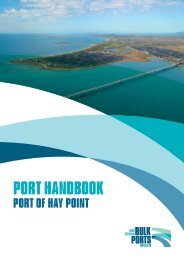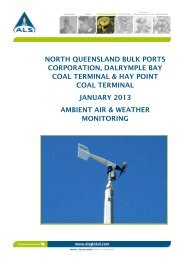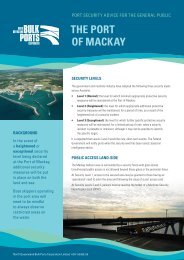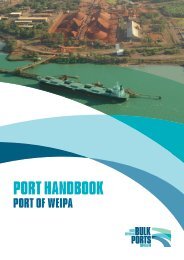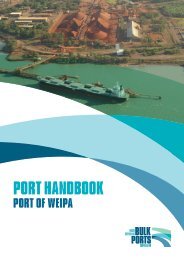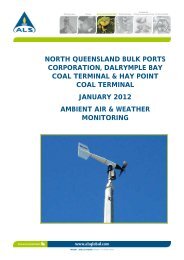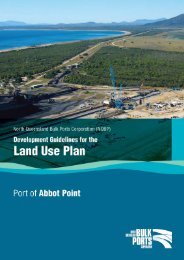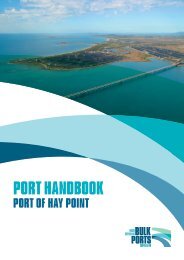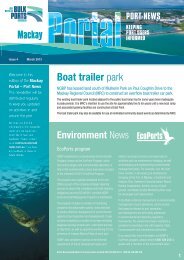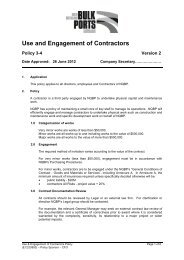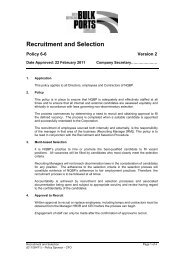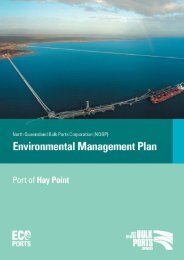Terms of Reference - North Queensland Bulk Ports Corporation
Terms of Reference - North Queensland Bulk Ports Corporation
Terms of Reference - North Queensland Bulk Ports Corporation
- No tags were found...
Create successful ePaper yourself
Turn your PDF publications into a flip-book with our unique Google optimized e-Paper software.
Describe the proposed stormwater drainage system and any proposed treatment,storage, re-use and disposal arrangements, including any <strong>of</strong>f-site services. Providedetails on the standard <strong>of</strong> proposed stormwater treatment systems, including examples<strong>of</strong> quality improvement devices (for example, sediment removal, gross pollutant traps)and potential discharge points (for example, spread <strong>of</strong> flow and scour protection).Provide information on how water quality will be managed in accordance with therelevant NWQMS guidelines, Water Quality Guidelines for the Great Barrier ReefMarine Park (Commonwealth <strong>of</strong> Australia 2010b) and state and local policies andguidelines.For additional discussion on stormwater drainage and treatment see Part B, section 5.5<strong>of</strong> this TOR. The EIS should include cross-references between the sections asappropriate.4.5.8. Sewerage and wastewaterDescribe the sewerage and wastewater infrastructure required by the project, including:• options assessed for wastewater treatment• the treatment measures/precautions <strong>of</strong> any wastewater generated by the project,whether temporary or not, that will be discharged to council sewerage infrastructureso that the sewage will not adversely impact on treatment processes at localgovernment wastewater treatment plants• measures required to mitigate any risks to the environment from discharges andoverflows, with reference to relevant NWQMS guidelines and other state and localwater quality policies and guidance• buffers between disposal and irrigation areas and other use areas, that is, currentrural operations <strong>of</strong> landholders surrounding the proposed rail corridor• peak design capacity evaluation <strong>of</strong> the wastewater treatment system and associatedinfrastructure using equivalent persons as the measure <strong>of</strong> capacity• the proposed disposal and re-use <strong>of</strong> the treated effluent and the management <strong>of</strong>such use. An irrigation plan should be provided detailing where the use <strong>of</strong> treatedeffluent is likely. Details <strong>of</strong> the likely impacts <strong>of</strong> treated effluent on groundwaterquality should also be provided• the siting and maintenance regime for the system• how the development will manage operation <strong>of</strong> the wastewater treatment anddisposal system in circumstances <strong>of</strong> disaster or disruption to power supplies,including determination <strong>of</strong> the potential emergency effluent storage that would berequired in an extended rain event (one in 50 and one in 100-year) wet weatherstorage, accounting for climate change.Address any statutory requirements in relation to ship-sourced pollutants under theTransport Operations (Marine Pollution) Act 1995 with particular regard to sewage,garbage and oily waste (see Part B, Section 5.9.2).For additional discussion on sewerage and wastewater infrastructure see Part B,Section 5.5 <strong>of</strong> this TOR. The EIS should include cross-references between the sectionsas appropriate.Contents <strong>of</strong> the EISDudgeon Point Coal Terminals Project<strong>Terms</strong> <strong>of</strong> reference for an environmental impact statement- 23 -



